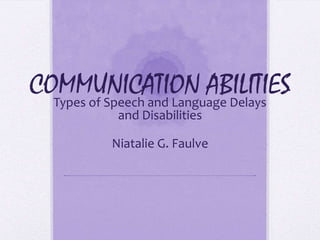
Communication Abilities
- 1. COMMUNICATION ABILITIES Types of Speech and Language Delays and Disabilities Niatalie G. Faulve
- 2. Types of Speech and Language Delays and Disabilities Two Main Categories of Communication Disorders: 1. Speech disorders are related to voice (quality, pitch loudness, resonance, duration) articulation ( speech sounds), and fluency ( rate and rhythm of flow) 2. Language disorders are related to comprehension or use of spoken or written words. These skills are related to the reception of language.
- 3. Important Components in Evaluation of Communication Skills • General Behavior and Ability to Pay Attention -the child’s ability to make or maintain eye contact is observed -the child’s ability to pay attention to age- appropriate activities is noted, as are the levels of activity, distractibility, impulsiveness, and perseverance -the child’s frustration level when faced with a challenging task is also evaluated
- 4. Prelinguistic Skills ( Presymbolic) • Ability to pay attention to visual and auditory information • Ability to imitate gestures and sounds • Development of object permanence • Ability to take turns • Ability to understand that objects have intended purposes • Use of basic communicative gestures and the ability to associate a heard word with its meaning Receptive Language Skills Receptive language refers to language comprehension. • Understanding vocabulary (words) • Understanding sentences and grammatical structures • Following directions • Understanding concepts
- 5. Expressive Language Skills Expressive language refers to the language that the child produces Possible causes for language disabilities 1. Hearing loss 2. Mental retardation 3. Autism 4. Illness 5. Abnormal brain development or brain injury 6. Emotional disturbance 7. Environmental deprivation
- 6. 3 Parts of Expressive language • Expressive vocabulary- number and types of words a child has acquired • Syntax- word and sentence formation • Pragmatic development- the ability to use language socially
- 7. Articulation Skills Articulation is the production of speech sounds Types of Articulation Errors Distortion- unfamiliar sound production Substitution- incorrect sound is used within a word Omission- sound is omitted within a word Addition- sound is added within a word Voice Some aspects assessed formally and informally are the: Pitch- high or low frequency Volume- loud or soft Quality- hoarse or nasal
- 8. Fluency Fluency problems, often referred to as stutteringor dysfluency, are interruptions in the flow of speech. Oral-Motor Skills It relates to the development of the mouth and surrounding area in terms of its structure and functionality Hearing Primary means of learning to communicate for most children
- 9. Play skills It is important for the speech-language pathologist to engage or observe children during play activities to best understand their level of speech and language development. Problem-Solving Skills As children become older, they should be able to analyze things that they encounter in more complex ways.
- 10. Importance of Early Intervention The sooner the developmental problems are identified, the sooner they may be addressed. Early intervention may result in more effective and shorter treatment. Speech and Language Therapy Many communication problems can be improved by therapy. Speech and language therapy occurs within a wide variety of settings, ranging from an individual session in a clinic or child’s home to a group session in a classroom.
- 11. Role of Team Members The collaboration between the therapist and the classroom teacher. Collaboration means that the lessons and activities are jointly planned and executed to fulfill both professionals’ objectives. Augmentative Communication AAC ( Augmentative and alternative communication)- refers to the use of technological device or system in addition to or in lieu of verbal communication. -includes gestural systems (sign language), low-tech visual systems (eye-gaze boards), and high-tech computerized devices.
- 12. Eye-Gaze Boards These are often useful for children who do not use speech PECS (Picture Exchange Communication System) is an augmentative system designed to help children acquire functional communication Communication Boards are similar to eye-gaze boards often used for children with mental or physical disabilities that prevent the effective use of sign language or speech
- 13. High-Tech Devices include anything from a single switch to a complex computerized device Facilitated Communication when this method is used, a facilitator supports the child’s hand and arm, allowing the child to communicate by typing on a keyboard Parents Role Parents need to communicate to their children verbally and non-verbally, that therapy is a positive experience
- 14. Methods Likely to Encourage Speech and Language Development • Make talking and conversation a positive experience • Talk, talk, and talk to the child about what they and others are doing • Play pretend and guessing games • Sing songs, and use nursery rhymes • Sort and classify things in the child’s environment
- 15. Methods That Discourages Language Development • Correcting speech or language errors by telling the child “No”, implying that the child did something wrong, or insisting that the child repeat a correct model. • Discussing any suspected speech or language problems in front of the child. • Withholding favorite things to make the child speak. • Placing unreasonable demands on the child such as insisting that they speak or perform in front of others • Interrupting the child. • Allowing others to tease or make fun of the child.
- 16. Thank You!!!!
